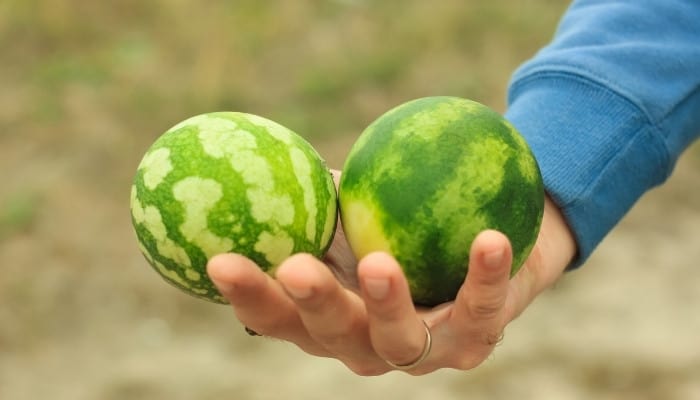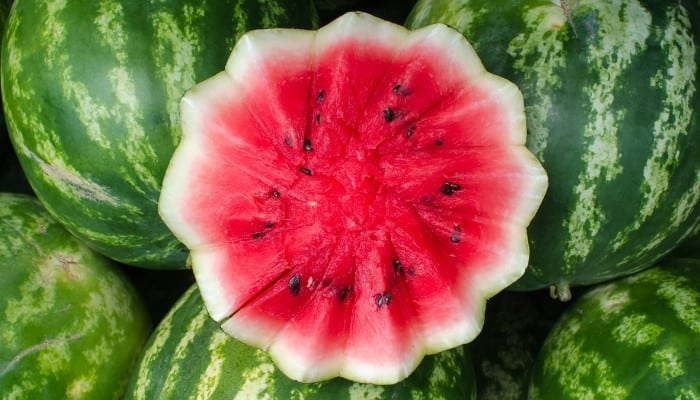Surprisingly, it is entirely feasible to grow watermelon using hydroponic techniques.
However, they do require quite a bit of water and nutrients to thrive in comparison to other hydroponic crops.
Can you grow watermelon hydroponically? You can grow watermelon hydroponically relatively easily. The key to success in growing them hydroponically is knowing that they require more water and nutrients than other types of hydroponic crops. Growing watermelon hydroponically also requires a shelving system to hold the weight of the melons.
Read on below and learn all about growing watermelon hydroponically, including growing tips!
Growing Watermelon Hydroponically
Watermelon isn’t the likeliest or most common crop for growing hydroponically. However, it is more than possible.
The main differences between growing hydroponic watermelon and other crops is that watermelon takes up more space, requires a larger amount of water and nutrients, and needs additional support for its weight.
Another concern with growing watermelon hydroponically is the amount of light they require.
Outside, watermelons need a minimum of 8 to 10 hours of direct sunlight. Inside, they require an equivalent amount of light from your grow lights.
Below, we dive deeper into each individual aspect of how to grow watermelon hydroponically.
Best Hydroponic Systems for Growing Watermelons
The first step to a successful hydroponic crop of watermelons is selecting and setting up the best type of hydroponic system for the operation.
Although hydroponic watermelon may be grown with a number of different types of hydroponic systems, one system stands out: the ebb-and-flow system.
Ebb and Flow System
An ebb-and-flow hydroponic system is best for growing watermelon due to its use of one large reservoir and a steady supply of nutrient solution that is constantly available for these water-based fruits to absorb.
Using ebb-and-flow systems for hydroponic watermelon also cuts down on the amount of time and attention you need to spend on the operation.
For example, with Dutch buckets, DWC, RDWC, and other forms of hydroponic systems, you must keep a close eye on a number of reservoirs.
Each grow site with a reservoir needs monitoring for water, nutrient, pH, and EC levels (I explain here). Using an ebb-and-flow system cuts all of that work out of the picture, save for the main reservoir.
Check out the basics of an ebb-and-flow system in my article here.
Growing Mediums for Hydroponic Watermelons
Hydroponic watermelon grows and thrives in inert, sterile growing mediums.
One of the most popular growing mediums for growing watermelons hydroponically is LECA (explore this excellent option here) or other pea gravel-sized mediums.
In addition, there are several other options that hold water just as well as clay, if not even better.
Peat moss, pine bark, coconut coir, vermiculite, and perlite are among the most preferred (aside from clay-based options).
Also, depending on what type of growing medium you choose, keep in mind that you may add sand and clay or gravel to help increase the water retention if needed.
Correct Hydroponic Water Temperature and Humidity for Watermelons
Everything to do with water is crucial in hydroponics, including the temperature, but it is even more important with watermelons specifically.
That is because these big, tasty beauties consist of much more water than most other crops.
Temperature
Outside, watermelons grow best when the temperatures are between 65°F and 80°F. That said, some species of watermelons may withstand temperatures of up to 95°F.
Most species, however, suffer from slow growth or no growth when temperatures reach over 80°F or below 50°F.
Humidity
The correct humidity level for hydroponic watermelon is somewhere between 60% and 80%, depending on the species you are growing.
If grown inside, regular light misting may help achieve the preferred moisture levels for your watermelons.
Best Nutrients for Growing Hydroponic Watermelons
Watermelons thrive and grow best with liquid nutrients that consist of well-balanced macronutrients and micronutrients. Most general-purpose fertilizers for hydroponics work well.
If you’re the DIY type, a popular homemade nutrient solution for growing watermelons consists of 2 parts general-purpose plant food and 1 part Epsom salts for every gallon of water.
Keep in mind, whether you use store-bought or homemade nutrient solutions for your watermelons, the water will need to be replaced along with the nutrients at least every two or three weeks.
Best Support Structure for Hydroponic Watermelons
One of the most unique aspects of growing watermelon hydroponically in comparison to other crops is that a support structure must be used.
Without a proper support structure, there is nothing to hold the weight of the watermelon (or keep the vine from snapping).
Shelving
Shelves are one of the most common types of support structures used for growing large watermelon hydroponically.
Tables or Benches
Low-profile benches or tables are another popular type of support system to utilize for holding the weight of a watermelon crop.
Nylon Mesh
For small round varieties of hydroponic watermelon, nylon mesh is the best support structure to utilize.
Lighting Requirements for Hydroponic Watermelon
Watermelons require quite a bit of light in comparison to many hydroponic crops, such as lettuce and microgreens.
For most species, at least 8 to 10 hours of light is needed each day. Some species may require even more, but few will require less.
Keep in mind that old leaves may need trimming as the plant continues to grow and the watermelon grows larger.
That way, more light can reach the newer leaves and promote steady growth rates.
Outside, greenhouses that receive full sun for most of the day offer excellent lighting for watermelons.
Additionally, they offer up a bit of protection from sudden drops in temperatures as well as from frost.
Tips for Successfully Growing Watermelons Hydroponically

1. Start Seeds in Rockwool or Peat Plugs
Sure, you can start your seeds in potting soil, wash off their roots, and transfer them to your hydroponic system.
However, the best way to ensure a good crop of watermelon is to start the seeds in rockwool cubes, like these from Amazon, or peat starters.
Water the seeds thoroughly, and keep them completely moist until sprouting occurs.
2. Transfer As Quickly As Possible
You may want to allow your plant to develop as much as possible before transferring it, as you would with certain garden variety plants.
But, with hydroponic watermelon, you’ll need to plug the new plant into your system just as soon as it begins visibly forming roots.
No dilly-dallying, just get those babies into the growing medium ASAP.
3. Use a Support System
It may be tempting to try your hand at growing watermelon without a support system, depending on the layout of your hydroponic setup, but we highly recommend you don’t.
A support system not only keeps your fruits off the ground, but it also keeps your crops further away from pests, bacteria, and diseases that are ground-based.
4. Keep Nutrients Topped Off
It may seem a bit basic for a tip, but keeping your nutrients topped off constantly is genuinely one of the best things you can do to ensure a truly tasty batch of watermelons.
Check your reservoir(s) daily with a pH and EC meter (like this one with auto temperature compensation), and replace the water fully every 14 to 21 days.
5. Practice Patience (Don’t Harvest Too Soon)
Practicing patience matters when it comes to these big juicy melons.
Once they first appear to stop growing, it can be tempting to snatch them off the vine, but you need to give it more time before harvesting it.
Just because it reaches its full size doesn’t mean it’s fully ripe yet. Give it a bit more time to allow it to become as sweet, juicy, and flavorful as possible.
A Final Word About Growing Watermelons Hydroponically
Growing watermelon hydroponically isn’t nearly as crazy or complicated as it may look.
Truthfully, the biggest difference is the uptake of water and nutrients as well as requiring a support system for the fruit.
If you plan to try your hand at growing hydroponic watermelon sometime soon, please feel free to refer back to this guide as often as needed to help you along your journey to a successful crop of hydroponic watermelons!

